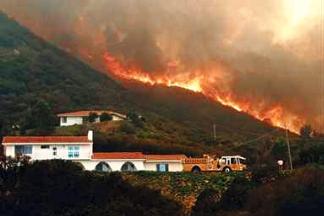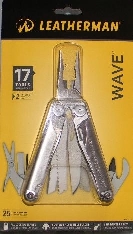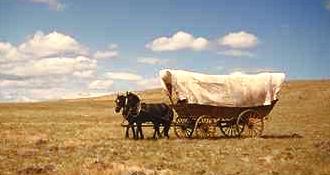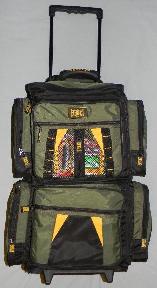
















An Emergency Backpack or a Bug-Out-Bag
Copyright © February 24, 2010 by Robert Wayne Atkins, P.E.
All Rights Reserved.
Introduction
 If you were told that you had five-minutes to evacuate your current home or you and your family would perish, what would you do?
If you were told that you had five-minutes to evacuate your current home or you and your family would perish, what would you do?
If you already had an emergency backpack or suitcase packed for each member of your family then you could spend those five minutes collecting any food, medicine, and clothing that you should take with you, along with any jewelry or other valuables, and your family photograph album, and your fireproof metal box that already contains the original copies of all your birth certificates, marriage licenses, diplomas, school transcripts, business certifications or licenses, deeds, wills, and other important documents.
If you had taken the time to think about this ahead of time then you should have already made a list of the items you absolutely wish to take with you along with where those items are usually stored. This list will help you to quickly collect everything you really need without overlooking something critical due to the pressure of the current evacuation situation.
The emergency backpack or suitcase is usually referred to as a bug-out-bag of "BOB" for short.
Some people recommend packing a "BOB" for a 72-hour or 3-day emergency. I do not agree with this advice. My personal opinion is that your "BOB" should give you the option to survive for at least six-months if you are forced to evacuate your home. Obviously you could not store a six-month food supply in one backpack but you could store enough of everything else to last each member of your family for at least six-months. If an unexpected hard times event forces you to quickly abandon your home, then after you put everyone's emergency "BOB" into your escape vehicle then you could put as much food as possible into your vehicle, and then you could abandon your home.
The items you store inside your "BOB" should be high-quality new items instead of old items that are not in very good condition. The reason is simple. If a hard times tragedy event occurs and you are forced to use the stuff in your "BOB" then those items may be all that you have for many, many years into the future. Wouldn't it be nice to have high-quality new equipment and clothes instead of things that are almost ready to fall apart?
The Most Important Contents of an Emergency Backpack or Bug-Out-Bag
The average family will need a separate "BOB" for each member of the family plus a special family "master" backpack that contains items that will be shared by everyone in the family.
Some minimum suggestions for a "BOB" are as follows:
- A master backpack for the entire family should contain the following:
- A really big detailed map of your state that shows all the major roads and all the secondary roads.
- Separate individual maps of all the states that adjoin your state.
- Good maps of each of the National Forests in your state and the nearby states that show all highways, dirt roads, hiking trails, camp sites, and rivers.

- A "Coghlan's Six Function Whistle Compass" with a thermometer, a whistle, a mirror, a magnifying glass, and an LED flashlight (cost about $10 at most Army/Navy Surplus Stores).
- A portable Katadyn Pocket Water Filter (cost about $230).
- A magnesium fire starter (contains magnesium and "fire steel") (cost about $8).
- A stainless steel camping mess kit with cook pots and enough stainless steel plates and tableware for each member of your family (cost about $25).
- Pair of large loose-fitting leather gloves with long wrists (wear them when you need to cook over a wood burning fire) (cost about $5).
- Dish towel and a dish cloth and a reusable pot scrubber pad.
- A variety of vegetable seed packets, such as sugar beets, carrots, radishes, corn, spinach, and tomatoes. Each spring replace last year's seed packets with fresh seed packets (long-term food) (total cost between $1 to $6).
- Twelve professional quality wild game snares (short-term and long-term food) (total cost about $15).
- At least one monofilament gill net for fishing (short-term and long-term food) (cost about $40).
- At least one big spool of monofilament fishing line (short-term and long-term food) (cost about $3).
- Approximately 100 fish hooks in a variety of different sizes (short-term and long-term food) (cost about $3).
- Merck Manual of Medical Information, 2nd Home Edition, 2004, paperback, not the most recent edition (cost about $14).
- A reasonable first aid kit and some anti-itch cream and some triple antibiotic ointment.
- A box of 100 additional one-inch wide bandages(you can cut a big bandage down into a smaller one if necessary) (cost about $3).
- A small sewing repair kit with thread, needles, a needle threader, a thimble, and a few extra buttons (cost about $2).
- Stainless steel barber scissors, fingernail clippers, toenail clippers, nail file (buy good quality items - total cost about $15).

- A Leatherman Wave Multitool (cost about $70).
- A stainless steel hatchet with a leather sheath (cost between $9 to $45).
- A folding "Sierra Saw" for sawing wood at a campsite (cost about $9).
- A folding shovel (cost about $12).
- A tarp (emergency shelter and rainwater collection) (cost between $10 to $20).
- One roll of duck tape (cost about $3).
- 12 or more heavy-duty one-gallon zipper freezer bags for the temporary storage of rainwater at your camp site.
- 12 or more heavy-duty one-gallon zipper freezer bags for the temporary storage of food at your camp site, such as dried meat jerky, or fresh fruit and fresh vegetables, or dried fruit and dried vegetables.
- At least 200 feet of strong thin nylon or polypropylene twine (minimum breaking strength of at least 100 pounds) (cost about $3).
- 115 feet of 22 gauge floral wire (this item will be discussed in more detail later) (cost about $3).
- A portable world-band radio that can operate on normal AA or AAA batteries (cost about $100).
- A solar battery charger that will recharge the four basic standard sizes of rechargeable flashlight batteries: AAA, AA, C, and D (cost about $25).
- Twelve rechargeable AA or AAA batteries manufactured by at least two different companies, such as Duracell, Energizer, or Rayovac. Separate them and store them two per small package to prevent the loss of the entire set of batteries if one of them starts to leak (cost about $10).
- SAS Survival Guide by John "Lofty" Wiseman, or the Boy Scouts Handbook, First Edition, 1911, Dover printing (cost between $8 to $10).
- A compact copy of the Holy Bible with reasonable size print.
- A flash drive with digital copies of all the important legal documents for your entire family, such as birth certificates, marriage licenses, deeds, titles, retirement account records, diplomas, school records and transcripts, immunization records, medical insurance cards, insurance policies, family photographs, and anything else your family would like to preserve and take with you in digital form. A digital copy can be of great assistance in helping you to get a replacement original copy if you are not able to take the originals with you.
- Each member of your family should have his or her own personal backpack that contains the following:
- Personal hygiene items such as: large bar of soap, toothbrush, big tube of toothpaste, dental floss, hand mirror, hair comb or brush, a few bandages, and a razor if the person shaves. A female backpack should also contain feminine pads.
- If appropriate, an extra spare pair of prescription eyeglasses or reading glasses.
- 20 paper towels (emergency toilet tissue).
- One pair of latex gloves one size larger than the person would normally wear.
- Four soft sponges.
- Your normal daily prescription medicines plus whatever pain relief tablets you prefer.
- Food that does not need to be cooked but has a long shelf life (some 2400 or 3600 Mainstay lifeboat food ration bars, plus some miniature tootsie rolls or caramels that are vacuum sealed, plus some multivitamins that are vacuum sealed).
- Water container such as a clean empty Gatorade bottle in an outside pocket of the backpack (fill the empty bottle with fresh water just before leaving).
- 6 clean heavy-duty one-gallon zipper freezer bags for the temporary storage of rainwater (or food) at your camp site.
- Good quality rain poncho with attached hood (may also be used as the roof of an emergency shelter, or for rainwater collection, or as a wind breaker during bad weather).
- Hand towel and a wash cloth.
- Thin lightweight blanket.
- Clothing (t-shirt, shirt, pants, lightweight jacket).
- Four pair of socks.
- Two pair of underwear.
- Ski mask.
- One pair of soft warm gloves.
- An adult and a teenager should also have a pair of good flexible leather work gloves.
- Safety eye glasses.
- Fixed blade hunting knife (without a gut hook) and a belt sheath.
- Folding blade pocket knife with no more than four blades (not a Swiss Army Knife).
- Sixteen books of paper matches, 20 matches per matchbook (total of 320 paper matches that are vacuum sealed).
- Butane lighter.
- High quality LED flashlight that operates on 3 AAA batteries. An LED flashlight consumes significantly less battery power than a traditional flashlight and the LED bulb never needs to be replaced (100,000 hours).
- Three Energizer "Ultimate Lithium" AAA batteries stored outside the flashlight.
- A paperback novel that the person has not yet read but would find entertaining, or a comic book, or a coloring book and some crayons or colored pencils.
- A deck of 52 playing cards, or a deck of "Uno" cards, or five Yacht six-sided dice, or some other small travel game that could keep an adult or a child entertained. A game that can be played by two or more people or by one person as a solitaire game is recommended.
- A small pad of ruled paper (50 sheets, 5" x 7"), a wood pencil, and a small pencil sharpener.
- Photocopies of important documents, such as a birth certificate, immunization records, school records, driver's license, medical insurance cards, daily medicine prescriptions, etc. (not digital copies).
An adult male backpack should not exceed approximately 30 pounds.
An adult female backpack should not exceed approximately 25 pounds.
Teenager and children backpacks should not weigh more than the individual can carry comfortably.
 One of the common mistakes that people make is to load a backpack and then see if they can lift it. If they can lift it they think it is okay. They are wrong. The weight of the backpack should be something you could carry for many miles and not just across the room. In the 1800s when people traveled in covered wagons on their way west they would frequently start with a wagon loaded to its capacity and which could be pulled by their team of mules or oxen. But their team would quickly become exhausted and they would have to stop and rest and they would continue to fall further and further behind the rest of the wagon train. Then they would start throwing stuff out of their wagon beside the trail so they could catch up with the rest of the wagon train. Before they began their trip these people had been advised to lighten their wagon load but they were hard-headed and they would not listen to good advice. A smart person is able to learn from the mistakes of others without having to repeat those same mistakes himself.
One of the common mistakes that people make is to load a backpack and then see if they can lift it. If they can lift it they think it is okay. They are wrong. The weight of the backpack should be something you could carry for many miles and not just across the room. In the 1800s when people traveled in covered wagons on their way west they would frequently start with a wagon loaded to its capacity and which could be pulled by their team of mules or oxen. But their team would quickly become exhausted and they would have to stop and rest and they would continue to fall further and further behind the rest of the wagon train. Then they would start throwing stuff out of their wagon beside the trail so they could catch up with the rest of the wagon train. Before they began their trip these people had been advised to lighten their wagon load but they were hard-headed and they would not listen to good advice. A smart person is able to learn from the mistakes of others without having to repeat those same mistakes himself.
 If possible you should also have at least one heavy-duty folding luggage carrier with large wheels. The luggage carrier could be used to carry several backpacks or suitcases at one time by one strong healthy person. In an emergency a small child could sit on top of a backpack on the luggage carrier and be pulled along behind an adult. If you have two small children then you should consider purchasing two heavy-duty folding luggage carriers. Carrying a small child in your arms will quickly exhaust you.
If possible you should also have at least one heavy-duty folding luggage carrier with large wheels. The luggage carrier could be used to carry several backpacks or suitcases at one time by one strong healthy person. In an emergency a small child could sit on top of a backpack on the luggage carrier and be pulled along behind an adult. If you have two small children then you should consider purchasing two heavy-duty folding luggage carriers. Carrying a small child in your arms will quickly exhaust you.
If you have a growing child then you should consider purchasing clothes one size larger than your child currently wears and putting those clothes into your child's BOB. For example, if your child currently wears a size 6 then buy some size 7 clothes and put those clothes in the child's BOB. After your child grows a little bit and can wear a size 7 then remove those clothes from the backpack and give them to your child and immediately replace them with the next larger size, such as a size 8. This way the clothes in your child's backpack will always be new. And your child can gradually grow into that clothes size if a hard times event occurs. And if a hard times event doesn't occur then you will not have wasted any money because your child will always be wearing the clothes you purchased last year at last year's more affordable prices.
 You can avoid mold and mildew problems by vacuum sealing each item before putting it into your backpack. For example, you could vacuum seal the soap, the paper towels, the clothes, the hand towels, the blankets, the feminine pads, the knives, the medicines (if appropriate), the candy, and the matches. Vacuum sealing will remove all the air trapped between the clothes, the towels, and the blankets and this will reduce their size to approximately one-half their original folded size and this will provide more storage space inside each of the backpacks.
You can avoid mold and mildew problems by vacuum sealing each item before putting it into your backpack. For example, you could vacuum seal the soap, the paper towels, the clothes, the hand towels, the blankets, the feminine pads, the knives, the medicines (if appropriate), the candy, and the matches. Vacuum sealing will remove all the air trapped between the clothes, the towels, and the blankets and this will reduce their size to approximately one-half their original folded size and this will provide more storage space inside each of the backpacks.
Store the butane lighter inside two heavy-duty zipper freezer bags (one-pint size) but do not vacuum seal the butane lighter.
(Note: You should also not vacuum seal ammunition inside a vacuum bag. The vacuum may gradually and slowly begin to pull the primer and/or the bullet out of their brass shell casing and if that happens then you will have a dangerous round of ammunition that may not fit into your firearm, or it may result in an disastrous accident when you try to shoot it.)
One very common problem with an emergency backpack is when a member of your family needs something and decides to "temporarily" borrow that item from his or her backpack. Later when a real emergency occurs you discover to your horror that everyone's backpack has been vandalized by the members of your own family.
Respectfully,
Grandpappy.
Grandpappy's e-mail address is: RobertWayneAtkins@hotmail.com




































 If you were told that you had five-minutes to evacuate your current home or you and your family would perish, what would you do?
If you were told that you had five-minutes to evacuate your current home or you and your family would perish, what would you do?

 One of the common mistakes that people make is to load a backpack and then see if they can lift it. If they can lift it they think it is okay. They are wrong. The weight of the backpack should be something you could carry for many miles and not just across the room. In the 1800s when people traveled in covered wagons on their way west they would frequently start with a wagon loaded to its capacity and which could be pulled by their team of mules or oxen. But their team would quickly become exhausted and they would have to stop and rest and they would continue to fall further and further behind the rest of the wagon train. Then they would start throwing stuff out of their wagon beside the trail so they could catch up with the rest of the wagon train. Before they began their trip these people had been advised to lighten their wagon load but they were hard-headed and they would not listen to good advice. A smart person is able to learn from the mistakes of others without having to repeat those same mistakes himself.
One of the common mistakes that people make is to load a backpack and then see if they can lift it. If they can lift it they think it is okay. They are wrong. The weight of the backpack should be something you could carry for many miles and not just across the room. In the 1800s when people traveled in covered wagons on their way west they would frequently start with a wagon loaded to its capacity and which could be pulled by their team of mules or oxen. But their team would quickly become exhausted and they would have to stop and rest and they would continue to fall further and further behind the rest of the wagon train. Then they would start throwing stuff out of their wagon beside the trail so they could catch up with the rest of the wagon train. Before they began their trip these people had been advised to lighten their wagon load but they were hard-headed and they would not listen to good advice. A smart person is able to learn from the mistakes of others without having to repeat those same mistakes himself. If possible you should also have at least one heavy-duty folding luggage carrier with large wheels. The luggage carrier could be used to carry several backpacks or suitcases at one time by one strong healthy person. In an emergency a small child could sit on top of a backpack on the luggage carrier and be pulled along behind an adult. If you have two small children then you should consider purchasing two heavy-duty folding luggage carriers. Carrying a small child in your arms will quickly exhaust you.
If possible you should also have at least one heavy-duty folding luggage carrier with large wheels. The luggage carrier could be used to carry several backpacks or suitcases at one time by one strong healthy person. In an emergency a small child could sit on top of a backpack on the luggage carrier and be pulled along behind an adult. If you have two small children then you should consider purchasing two heavy-duty folding luggage carriers. Carrying a small child in your arms will quickly exhaust you. You can avoid mold and mildew problems by vacuum sealing each item before putting it into your backpack. For example, you could vacuum seal the soap, the paper towels, the clothes, the hand towels, the blankets, the feminine pads, the knives, the medicines (if appropriate), the candy, and the matches. Vacuum sealing will remove all the air trapped between the clothes, the towels, and the blankets and this will reduce their size to approximately one-half their original folded size and this will provide more storage space inside each of the backpacks.
You can avoid mold and mildew problems by vacuum sealing each item before putting it into your backpack. For example, you could vacuum seal the soap, the paper towels, the clothes, the hand towels, the blankets, the feminine pads, the knives, the medicines (if appropriate), the candy, and the matches. Vacuum sealing will remove all the air trapped between the clothes, the towels, and the blankets and this will reduce their size to approximately one-half their original folded size and this will provide more storage space inside each of the backpacks.
